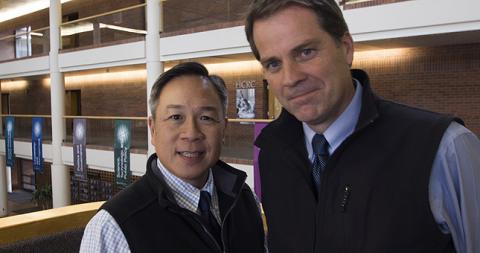
Michael Goh and Peter Demerath are one of several Generation Next/UROC Faculty Fellows working to find solutions to Minnesota’s achievement gap

It’s a familiar story—across the country, white students are doing better academically than their classmates of different races and ethnicities who typically have lower test scores and higher dropout rates. This “achievement gap,” as it is commonly called, is particularly evident in Minnesota, where the gap between the performance of white students and students of color is among the highest in the nation.
Reasons for this ongoing educational disparity are numerous and complex, and many experts are working hard to find solutions, including several at the University of Minnesota Robert J. Jones Urban Research and Outreach Engagement Center (UROC). At the request of Generation Next, a non-profit led by former Minneapolis Mayor R. T. Rybak that aims to close the achievement gap in the Twin Cities, UROC tapped six University faculty members to be Generation Next/UROC Faculty Fellows.
Their two-fold mission: Answer the question of why there is an achievement gap in the Twin Cities and propose ideas for solving the problem. The Fellows’ first report Context Matters: Finding Community in Educational Equity Efforts, which was released in September, made clear that the challenge may be daunting but there is hope. And it starts with reframing the question.
Among their key findings the Fellows pointed out that calling the problem an “achievement gap” is “faulty and unacceptable.” Instead, they have chosen to use the term “educational equity,” which they believe more accurately reflects the complexity of the crisis.
“The notion of the achievement gap assumes achievement to be an individual act, but we believe that there is a whole contextual environment that contributes to an individual’s achievement, says Fellow Michael Goh, associate vice provost for Equity and Diversity and a professor in the College of Education and Human Development (CEHD).
Specifically, Goh explains, there is a very real gap between students when it comes to resource inequities. But the gaps in human relationships are equally as pressing, in particular the gap between teachers and kids, parents and communities. “For a teacher to be effective, we believe that you have to engage kids on all levels and to do that, you must understand the community the kids are coming from,” he says.
Goh, who directs the University’s Institute for Equity, Diversity, and Advocacy (IDEA), speaks from experience. For nearly 20 years he has been teaching courses aimed at helping future teachers ready themselves for interacting successfully with students in the classroom. Topping the list of important things would-be teachers need to understand is how to engage with diverse groups of students who will no doubt come from backgrounds very different from their own.
For help, Goh recently teamed up with Peter Demerath, an associate professor endeavoring to teach a similar CEHD class. Together they created a new course called Culture, Schools and Communities. “You must talk about how to connect teachers with students on a human relations level, a socio-economic level and an intercultural level before you can begin to develop academic goals,” he says. “Teachers can know their subjects, but until they bridge these gaps, learning will not occur.”
As a Fellow, Goh was charged with selecting four additional experts to serve on his team, with all six teams being responsible for submitting ideas and recommendations for the group’s September report (see attached). Considering his collaboration with Demerath, Goh asked that he also be named a Fellow and co-leader of their team, which includes associate professors Rashné Jehangir, Amanda Sullivan and Bhaskar Upadhyay.
In addition to stating that they believe achievement is not an individual act but rather the consequence of multiple inequalities, Goh and Demerath’s team identified many relationships that impact educational equity. Some of their suggestions include emphasizing social-emotional learning, involving families in ways that demystify school practices and policies and increasing students’ sense of belonging and understanding of the need for higher education.
“To be successful in this gap teachers have to be equipped with the belief that every student can learn and achieve,” Goh says, adding that he and the others are happy for the opportunity to work together on this issue as Fellows. “We realize that no one discipline has the right or complete answer. This is a wonderful opportunity to to put our interdisciplinary minds and hearts together to try to better understand the situation in order to then propose viable solutions.”